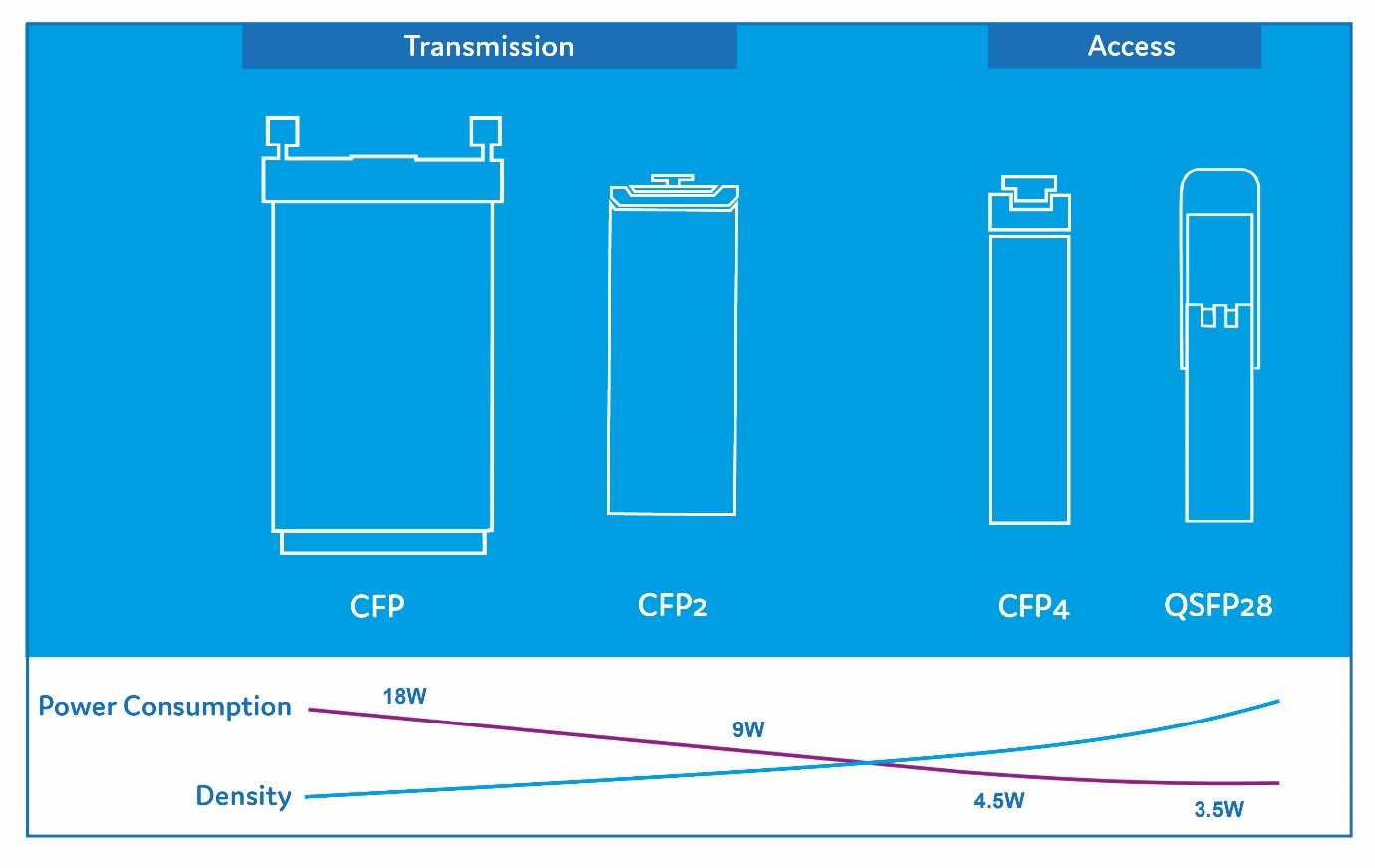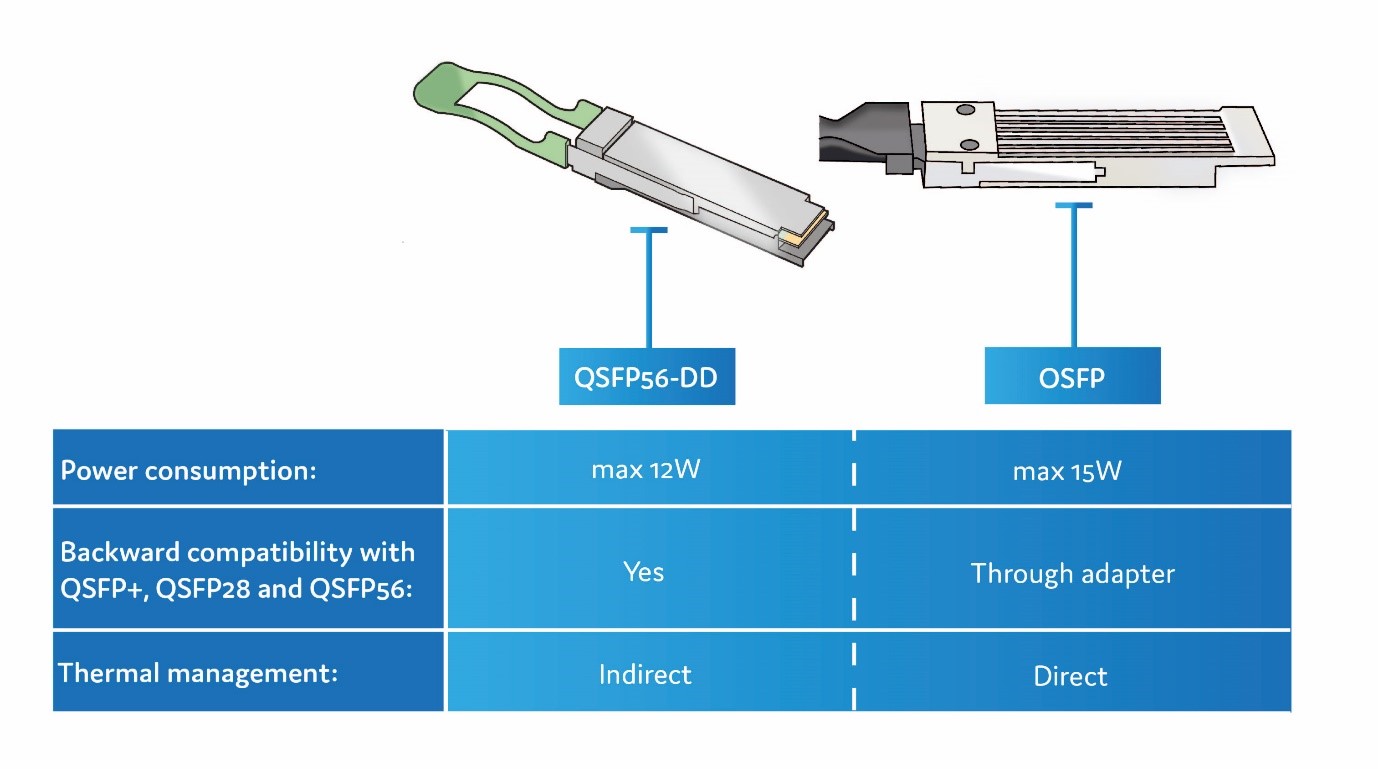datacenter
QSFP-DD, OSFP, and CFP8: Which Is the Best for 400G?
There are three criteria for a successful form-factor: small size, low power consumption, and interoperability between all systems vendors. As we all know, the SFP/SFP+ and QSFP+/QSFP28 are successful form-factors for 1G/10G and 40G/100G networks. In fact, for 100G networks, there are 4 different form-factors: CFP, CFP2, CFP4, and QSFP28.

100G form-factors: CFP vs. CFP2 vs. CFP4 vs. QSFP28
100G
The transmission departments in telecommunication networks need a pluggable transceiver able to cover long reach also using some dedicated technologies such as Coherent detection, while data centers need a small form-factor with the lowest power consumption and the lowest cost per unit due to their application is for short reach only (max 2km generally).
During the first instances of the 100G transceivers, the CFP form-factor was preferred because it was impossible to make a transceiver less than 12W power consumption, even for intermediate reach. Once the technology and components availability were better, it was then feasible to CFP2, and then CFP4. Still today, the Coherent technology for 100G and 200G is only available on CFP and CFP2 form-factors.
In parallel, the GAFA (Google, Apple, Facebook, and Amazon) with their phenomenal need for additional data center capacity, have pushed the QSFP28 form-factor for various short reach applications such as DAC, AOC, SR4, PSM4, and CWDM4.
Today, with the technology maturity and QSFP28 wide-adoption, most of the 100G applications are available on QSFP28 form-factor, with some exceptions for reach more than 40km, including Coherent detection.
400G
For 400G bit-rate, some essentials interrogations must be raised before going deeper into the subject:
- Who need the 400G transceivers?
- For which application?
- How about technology maturity?
- Any interoperability with former form-factors?
Following the market situation, 400G is a priority for the intra-connections in large data centers and at a lower scale for the transmission department in telecommunication networks. Because the 400G bit-rate requires PAM4 modulation, the reach is becoming more and more challenging and is limited to a few kilometers only. Longer reach will require Coherent detection technology and/or amplification, dispersion compensation, etc.
Again, we will observe a similar scenario: for 400G networks, a dedicated form-factor for the data center intra-connection (Intra-DC) and another one for transmission. However, thankfully it seems that “intermediate” form-factors won’t happen for 400G.
Intra-DC
400G is coming with 2 form-factors for Intra-DC: QSFP56-DD (QSFP-DD for QSFP Double Density) and OSFP (Octal SFP). Both form-factors are running 8 lanes of 50G PAM4 on the electrical side while the optical side can be either 8 lasers of 50G PAM4 or 4 lasers of 100G PAM4. In the 4-laser design, a “gearbox” is added to convert the PAM4 electrical signal from 8x50G to 4x100G.
The QSFP-DD is defined by the QSFP-DD MSA while the OSFP is defined by the OSFP MSA. They are similar but have three key differences:
- OSFP allows more power (15W) than QSFP-DD (12W) so that the OSFP allows an early adoption because it’s easier to release a technology designed for 15W than 12W.
- QSFP-DD port is backward compatible with QSFP including 40G QSFP+, 100G QSFP28, and 200G QSFP56, while OSFP port requires a QSFP to OSFP adapter.
- OSFP integrates thermal management directly into the form factor, but QSFP-DD does not.

400G form-factors: QSFP56-DD vs. OSFP
Both QSFP-DD and OSFP are designed for intra-DC applications including DAC, AOC and optical connection up to 2km. Additional variants will come for other applications such as Data Center Interconnect (DCI) with longer reach and other technology like DWDM super channel.
Transmission
The CFP8 form-factor, defined by the CFP MSA, is radically different compared to QSFP-DD and OSFP as:
- It allows up 24W power consumption.
- It has 16x25G NRZ on the electrical side instead of 8x50G PAM4 for QSFP-DD and OSFP.
- It has an MDIO management interface instead of I2C for QSFP-DD and OSFP.
With its large space and max 24W power consumption, the CFP8 is intended for transmission application. Available in an initial version of 10km, it has 16 electrical lanes of 25G NRZ which are converted to 8 lanes of 50G PAM4.
However, other variants are coming for longer reach, including Coherent detection technology. A version called CFP8 ZR (80km) will come at a later stage but it also opens the door for a CFP8 800G! By using the 16 electrical lanes and apply a 50Gbps PAM4 signal, it is feasible to reach 800G; then adding a DSP, Coherent detection and multiplexing lasers will enable the optical transmission. Clearly, this is not for today yet.

400G form-factors: QSFP56-DD vs. OSFP vs. CFP8
For 400G applications, others form-factors than the one listed above are also available, but for dedicated applications. We can list the COBO (Consortium for On-Board Optics) and the CDFP for cable application enabling 16 electrical lanes of 25Gbps.
Related article: QSFP-DD Might Be the Mainstream Form-factor of 400G Optical Transceivers.
Originally published at QSFP-DD, OSFP, and CFP8: Which Is the Best for 400G?.
